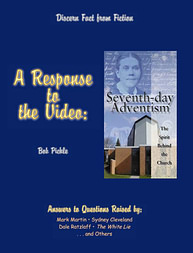|
A Response to the Video:
Seventh-day Adventism, the Spirit Behind the Church
by Bob Pickle
Answers to Questions Raised by:
Mark Martin, Sydney Cleveland
Dale Ratzlaff, The White Lie
. . . and Others
Discern Fact from Fiction
The Sabbath of the Fourth Commandment
< Prev T. of C. ... 159 160 161 162-163 164 165-167 168-169 ... Next >
| #162 & #163: "The idea of the seventh-day Sabbath was not original to Ellen
White though. It was in fact
initiated by a Seventh Day Baptist contact and Joseph Bates who subsequently talked James
and Ellen White
into the idea in 1846. Ellen obliged by conveniently having a vision and this introduced the
teaching to her
followers. 'I saw that the Holy Sabbath is, and will be, the separating wall between the true
Israel of God
and unbelievers.' Early Writings p. 85."—Mark Martin. |
#162: She obliged by conveniently having a vision. The
viewer is left with the impression that somehow Mrs. White pretended to
have a vision. However, as indicated under #44 and #112, her [p. 111] visions had a
definitely supernatural element. They could not be faked. There
was no way that Mrs. White could just decide that she was not going to breathe for an
extended period.
#163: Her vision introduced the Sabbath to her followers.
The vision referred to did not occur until April 3, 1847 (Life Sketches,
pp. 100, 101). It did not introduce the Sabbath, for the Sabbath was
already well introduced by that date.
The "Seventh Day Baptist contact," Rachel Oakes Preston, shared the Sabbath truth
with Methodist minister Frederick Wheeler in 1844. He
and many of his congregation in Washington, New Hampshire, began keeping the Sabbath by
the end of that year.
T. M. Preble had been a Freewill Baptist preacher in Nashua, New Hampshire. In
February 1845 he wrote an article endorsing the Sabbath,
which was read by Joseph Bates. Bates then accepted the Sabbath truth and wrote his own
tract about it in 1846.
"In the autumn of 1846," James and
Ellen White
"began to observe the Bible Sabbath,
and to teach and defend it" (Testimonies for the
Church, vol. 1, p. 75). This was roughly six months before the vision that
"introduced the teaching to her followers."
The vision did not result in the Sabbath being significantly more accepted among
Millerites. To the contrary, Mrs. White's acceptance of
the Sabbath in 1846 resulted in her being rejected by many of her Millerite friends. She had
fewer "followers" afterwards than before:
The light upon the fourth commandment, which was new and unpopular and generally
rejected by our Adventist brethren and sisters, we had
accepted. . . . opposition unexpectedly came upon us from those with
whom we had been united in the faith and glorious hope of the second advent
of our Saviour. . . . there were those with whom we had taken sweet
counsel together who denounced the third angel's message as
heresy.—Manuscript Releases, vol. 4, p. 402.
Imagine treating the "absolute authority figure" (see #21)
like this!
"Point 80 & 80a" are described in the documentation package's
index as "Saturday Sabbath teaching originated with a 7th day Baptist
and Joseph Bates in 1846." Yet when one turns to this section, Rachel Oakes, Joseph Bates,
and 1846 aren't even mentioned. Instead, events
of 1848 and 1849 are described.
If this video is ever redone, it would be best to involve someone who knows a bit
more about Adventism's history and doctrines.

|

|
Like this book?
Save your printer and your ink!
Buy the entire 160-page book for
just
$9.95 + S/H.
Automatic discounts start
at 5 copies.
|
|
|
< Prev T. of C. ... 159 160 161 162-163 164 165-167 168-169 ... Next >
| 


